Knowing How To Punish Your Audience
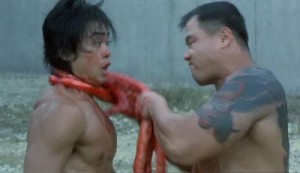 In 1991, a masterpiece of excess was unleashed around the world. Initially, it was a cult item, its greatest claim to fame was that a clip from the film, Riki-Oh: The Story of Ricky, was featured as the introduction to the Five Questions segment on The Daily Show, back when Craig Kilborn was hosting. The scene referenced had an enormous Asian man clasping his hands together, around the head of a much smaller foe, causing the head of the relatively miniature opponent’s head to explode, as if it were a vase falling from a great height.
In 1991, a masterpiece of excess was unleashed around the world. Initially, it was a cult item, its greatest claim to fame was that a clip from the film, Riki-Oh: The Story of Ricky, was featured as the introduction to the Five Questions segment on The Daily Show, back when Craig Kilborn was hosting. The scene referenced had an enormous Asian man clasping his hands together, around the head of a much smaller foe, causing the head of the relatively miniature opponent’s head to explode, as if it were a vase falling from a great height.
In the last 15 years, the cult of Riki-Oh has grown and has dripped into the mainstream enough to be referenced in Kill Bill vol. 2. There are other scenes in Riki-Oh that reflect such insane carnage; in one scene, Riki, unjustly in prison, fights another prisoner. The prisoner, after taking much punishment and realizing the futility in engaging with such an untouchable paragon of power as Riki, cuts his stomach wide open, committing Seppuku. The blood, flowing generously and the man’s death imminent, Riki looks sad and tries to help out the fallen warrior. However, it was only a trick, and the man pulls out his own intestines and wraps them around Riki’s neck in an attempt to strangle him.
Now, had the intestine attack scene described above been accomplished in a fashion that could possibly be taken seriously (though Riki-Oh certainly takes itself seriously), along with the endless supply of equally outrageous scenes, it would make up the most appalling movie ever made. Luckily, for the audience, everything is very rubbery looking and so the gore becomes humorous and Riki-Oh turns immediately to camp.
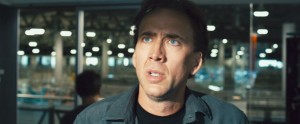 Two recent films have skated over this same territory of abundant and potentially horrifying death, the Nicolas Cage vehicle Knowing and the just released to DVD Punisher: War Zone, though each film takes its own approach.
Two recent films have skated over this same territory of abundant and potentially horrifying death, the Nicolas Cage vehicle Knowing and the just released to DVD Punisher: War Zone, though each film takes its own approach.
Knowing goes about its subject of impending doom with utter sincerity. That makes it easier to deal with the movie; if it had been self-aware it would have been pretty hard to sit through. And some audiences may still find that to be true, considering the basic content of the film considers the end of the world. Cage, playing a widowed, Atheist, MIT astrophysicist, discovers a piece of paper which accurately predicts every major disaster of the previous 50 years, and possibly some upcoming ones, tries to warn everyone or at least interfere. On the surface, this is very high-concept, with built-in character development as Cage has his eyes opened about religion, and finds his son at the center of the danger. The biblical implications and broad possibilities of interpretation in an end-of-the-world situation (is it our fault? God’s choice? A random event? Or simply inevitable?), which could easily play into the viewer’s level of guilt and God-fearing. And with the fully realized disasters, as directed by Alex Proyas, who also made The Crow and Dark City, Knowing could have easily turned into a nerve-wracking and eventually terrifying experience.
But then there’s the nagging detail that the movie is absolutely, laugh-out-loud awful. This is not a reaction to being scared by laughing it off, no, Knowing is a terrible film and yet so ambitious and bizarre, that even the requisite distraction of Nicolas Cage’s creatively styled hairpiece (a central figure in his last film, Bangkok Dangerous), is easily ten steps down the list of hilarious, to the point where I’d totally forgotten about it by Knowing’s batshit-insane conclusion.
 It isn’t the religious element that extricated me from being involved in Knowing, though that would the obvious scapegoat. It isn’t the Shyamalan feel of the first 45 minutes, which includes the slow moving camera, the quiet, the focus on children, and the opening scenes of paranoid domesticity, or the fact that the actress cast as the [shrieking and grating] heroine (Rose Byrne) is clearly in the movie because the producers couldn’t afford or couldn’t schedule Jennifer Connelly. It isn’t even the fact that the movie has a false premise, as Cage’s actions really have no effect on anything, nor would the mysterious creatures (who act a lot like The Strangers from Proyas’ Dark City) who guide Cage and his son have bothered with their intricate plan if none of it makes any difference, or that the entire film is just an endorsement of mental illness as helpful behavior. It is actually a combination of Cage’s acting, where he somehow manages to overemote and be stiff in the same shot, the awful special effects (which include CGI burning moose!) which drown out the effectiveness of what would have been a stunning all-in-one-shot plane crash sequence, and the overall need for the writers to hedge their bets by throwing in every possible excuse for the dour circumstances without having the confidence to stick with one concept.
It isn’t the religious element that extricated me from being involved in Knowing, though that would the obvious scapegoat. It isn’t the Shyamalan feel of the first 45 minutes, which includes the slow moving camera, the quiet, the focus on children, and the opening scenes of paranoid domesticity, or the fact that the actress cast as the [shrieking and grating] heroine (Rose Byrne) is clearly in the movie because the producers couldn’t afford or couldn’t schedule Jennifer Connelly. It isn’t even the fact that the movie has a false premise, as Cage’s actions really have no effect on anything, nor would the mysterious creatures (who act a lot like The Strangers from Proyas’ Dark City) who guide Cage and his son have bothered with their intricate plan if none of it makes any difference, or that the entire film is just an endorsement of mental illness as helpful behavior. It is actually a combination of Cage’s acting, where he somehow manages to overemote and be stiff in the same shot, the awful special effects (which include CGI burning moose!) which drown out the effectiveness of what would have been a stunning all-in-one-shot plane crash sequence, and the overall need for the writers to hedge their bets by throwing in every possible excuse for the dour circumstances without having the confidence to stick with one concept.
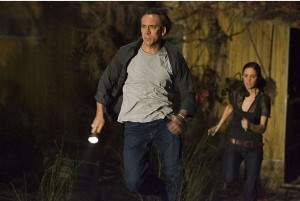 Really, it’s rather amazing that Knowing was ever financed (the script had been floating around for quite some time) and so it’s a shame that no one was willing to take the reins to insist the filmmakers to follow through on one streamlined idea, not just throw in religion, aliens, science, and anything else that might stick, and at the same time not offend anyone (even if Knowing is the most heinously violent PG-13 movie ever made). Have some confidence and stick with a viewpoint, especially if you’re willing to eliminate the human race. It’s a lesson that Michael Tolkin’s The Rapture (which is the conceptual brother to Knowing) understood all the way back in 1991, the year of Riki-Oh. It doesn’t matter if you can’t afford what you need for your vision, which Tolkin could not. The Rapture cost $1 million, but it is completely unnerving, unsettling, and frightening, even if you don’t buy into its worldview. The fact that with Knowing, Proyas had the money and chutzpah to show us the horrors and the delights of the apocalypse, but was too scared to alienate us by taking a philosophical stand is what ultimately damns the movie.
Really, it’s rather amazing that Knowing was ever financed (the script had been floating around for quite some time) and so it’s a shame that no one was willing to take the reins to insist the filmmakers to follow through on one streamlined idea, not just throw in religion, aliens, science, and anything else that might stick, and at the same time not offend anyone (even if Knowing is the most heinously violent PG-13 movie ever made). Have some confidence and stick with a viewpoint, especially if you’re willing to eliminate the human race. It’s a lesson that Michael Tolkin’s The Rapture (which is the conceptual brother to Knowing) understood all the way back in 1991, the year of Riki-Oh. It doesn’t matter if you can’t afford what you need for your vision, which Tolkin could not. The Rapture cost $1 million, but it is completely unnerving, unsettling, and frightening, even if you don’t buy into its worldview. The fact that with Knowing, Proyas had the money and chutzpah to show us the horrors and the delights of the apocalypse, but was too scared to alienate us by taking a philosophical stand is what ultimately damns the movie.
Punisher: War Zone, on the other hand, is willing to embrace its graphic violence and its lack of moral compass. The dialogue is dreadful (“I see you anywhere near hell and I’ll kick your ass out”), the plot holes are enormous (how did Jigsaw, the villain, escape prison, after he was surrounded by cops and buried in glass?), and Ray Stevenson, playing the title character, is a dead ringer for Mr. Big from Sex and the City, i.e., when Chris Noth was younger and lighter. But there’s so much energy and nonsense to embrace.
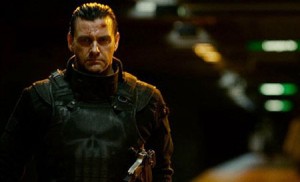 Much like with Riki-Oh, Punisher: War Zone has kills that make no physical sense (Stevenson punches through several people’s faces), and it has the lack of acting and grim temperament that fully posits it in cheap exploitation. It’s not that the movie itself is cheap, there’s clearly money in it, especially with the [expectedly] comic-book contrasty color schemes (each scene has a different colored lighting filter) and wonderfully elaborate, phony sets, but to think of a movie like this as big budget would be doing it a disservice. Think of it as the expensive side of cheap. There’s no pretense of even hiding that Punisher: War Zone is a movie, reality is thrown out the window from the opening moments where Stevenson shoots at the villains while spinning upside down on a chandelier (in a bit stolen from 3000 Miles to Graceland). The absence of human behavior is somewhat refreshing; a kid comes outside to ask his mom for a red pen, paying no mind to the fact that she’s pointing a large gun at a stranger and at an even larger man on the porch.
Much like with Riki-Oh, Punisher: War Zone has kills that make no physical sense (Stevenson punches through several people’s faces), and it has the lack of acting and grim temperament that fully posits it in cheap exploitation. It’s not that the movie itself is cheap, there’s clearly money in it, especially with the [expectedly] comic-book contrasty color schemes (each scene has a different colored lighting filter) and wonderfully elaborate, phony sets, but to think of a movie like this as big budget would be doing it a disservice. Think of it as the expensive side of cheap. There’s no pretense of even hiding that Punisher: War Zone is a movie, reality is thrown out the window from the opening moments where Stevenson shoots at the villains while spinning upside down on a chandelier (in a bit stolen from 3000 Miles to Graceland). The absence of human behavior is somewhat refreshing; a kid comes outside to ask his mom for a red pen, paying no mind to the fact that she’s pointing a large gun at a stranger and at an even larger man on the porch.
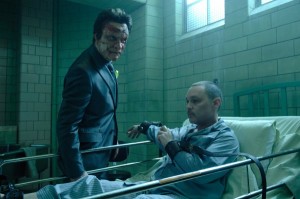 All the reprehensible behavior in Punisher: War Zone would have been irrelevant had it not been well made, but luckily, it has snappy editing and some truly brutal and effective beheadings. And that doesn’t take into account the scenes clearly inspired by The Warriors, wherein a huge number of thugs from with various ethnicities and affiliations are all sent out to find their common enemy, like a Benetton ad of death.
All the reprehensible behavior in Punisher: War Zone would have been irrelevant had it not been well made, but luckily, it has snappy editing and some truly brutal and effective beheadings. And that doesn’t take into account the scenes clearly inspired by The Warriors, wherein a huge number of thugs from with various ethnicities and affiliations are all sent out to find their common enemy, like a Benetton ad of death.
Punisher: War Zone gives irresponsible violence and single minded filmmaking a good name.
P.S. Knowing is strange and hilarious enough where it ought to be seen anyway, even if the stench of competence is nowhere to be found.
P.P.S Punisher: War Zone has a scene where a character shoots the heads off of dolls, the best “crimes committed against children’s toys” sequence since the notorious 10 minute stuffed animal massacre in Toys.



